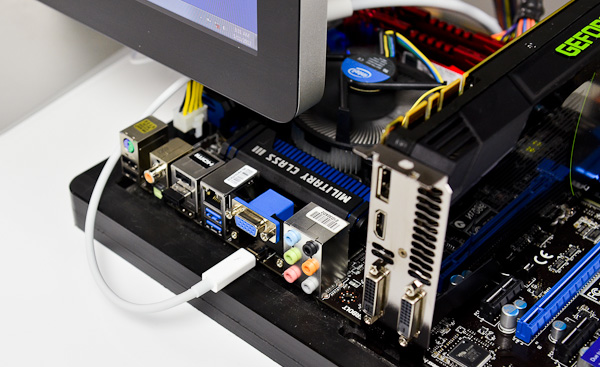A First Look at Thunderbolt on Windows with MSI's Z77A-GD80
by Anand Lal Shimpi on May 11, 2012 1:32 PM EST- Posted in
- Motherboards
- CPUs
- Intel
- MSI
- Thunderbolt
The Thunderbolt Display
The first test was hooking up Apple's Thunderbolt Display, the only Thunderbolt display device available on the market today. Although I shouldn't have been, I was a bit surprised when the display just worked. Intel's HD 4000 drove the 2560 x 1440 panel just fine and there weren't any funny issues displaying the lower res UEFI setup mode.
Despite Ivy Bridge being able to drive three independent displays, I was only able to simultaneously output to two connected displays on the GD80. All combinations of two worked however (TB + HDMI, TB + VGA, VGA + HDMI).
Once in Windows, the Thunderbolt Display's integrated GigE, Firewire and other controllers started popping up. Unfortunately Apple doesn't offer a direct download package for Thunderbolt Display drivers. You can either hunt down the controllers/drivers on their own, or you can build a Windows Support (driver) package using a Mac and the Boot Camp Assistant. I'd much rather Apple just offer an easy route for non-Mac Windows users to take advantage of the Thunderbolt Display as it's the only TB display on the market, but I can understand the lack of motivation there.
With the Boot Camp drivers installed, I got working GigE and Firewire 800. The Thunderbolt Display's integrated USB hub gave me issues however. Anything I plugged into it would either partially work (e.g. my mouse was detected but moving the cursor was far from smooth) or not work at all (e.g. my attached USB keyboard never worked). The other issue with the Thunderbolt Display is you get no brightness control, which can be a problem given how bright the panel gets. I've seen reports of people getting brightness control working via software tools but the solutions don't seem permanent.
Apple's Thunderbolt Display definitely works, but Windows users will likely want to wait for a Thunderbolt display that is built specifically with Windows in mind.
Virtu and Thunderbolt: It Works
From a software perspective, Thunderbolt is treated just like another display output driven by Intel's processor graphics. I installed a GeForce GTX 680 along with Lucid's Virtu GPU virtualization software to see if I could use the 680 for gaming but drive the display using Intel's processor graphics and the Thunderbolt port. The setup worked flawlessly.
Virtu recognized the configuration immediately once I had NVIDIA's drivers installed, and I was able to run the 680 headless - using only the Thunderbolt port to drive the external display. Intel's HD 4000 powered things in Windows, while the 680 kicked in for games.













98 Comments
View All Comments
repoman27 - Monday, May 14, 2012 - link
This is a persistent misconception regarding Thunderbolt—that it would somehow be able to offer greater bandwidth if it had only used optical media.Light Peak was developed from the outset with a target link rate of 10 Gbps (and using conventional fiber optic technology, not silicon photonics.) While optical cables have much less of a problem with signal attenuation than copper, which makes them more efficient for longer runs, when it comes to distances of less than 10 ft, which are the norm for typical PC use cases, copper is currently much cheaper, more power efficient, and user friendly.
Look around any data center and you'll most likely see lots of direct attach twinax copper for short runs. The highest bandwidth optical interconnects I'm aware of are rated for 56 Gbps (4x 14 Gbps lanes, full-duplex), but you can buy 3.0 m passive copper cables that can do that as well and cost way less.
Since you'd need a PCIe 3.0 x8 connection to fill the largest pipes we currently have at our disposal, I don't think copper's ability to scale is a real issue yet.
yyrkoon - Monday, May 14, 2012 - link
I stand corrected. For some reason I was thinking the bandwidth provided for each PCIe lane was half of what is indicated in the charts you provided a link to.Sorry about that - everyone.
I do not think anyone here would like to see this come into fruition more than myself. Having been let down by the industry many times in the past however. I just do not think it will ever happen. So I suppose I tend to get worked up over it.
BrightCandle - Saturday, May 12, 2012 - link
What I really want to see is 300W capable external cases for GPUs that support thunderbolt. Then we can have laptops that can be connected to modern high end GPUs that can game well when connected up. It also really needs to be able to drive the laptops screen.JKflipflop98 - Sunday, May 13, 2012 - link
That would be cool. Maybe we'll start seeing monitors with built in video card expansion slots or something.RamarC - Friday, May 11, 2012 - link
VGA and a PS/2 mouse/keyboard connector on a mobo with Thunderbolt? echos of 1988 still resound in the most modern of hardware...hechacker1 - Friday, May 11, 2012 - link
PS/2 is still best for n-key rollover, and it's an interrupt device rather than polling.But vga, yeah, that seems like a waste of a port, it should be dvi and just include the dongle.
DerPuppy - Friday, May 11, 2012 - link
PS/2 keyboard connectors still have advantages over usb keyboard connections...vga is legacy though, no doubt
tjoynt - Friday, May 11, 2012 - link
For home computers ps2 and vga don't make sense anymore, but for businesses (especially data centers) ps2 and vga are critical. USB + DVI KVM switches for more than 4 computers get *very* expensive, while 16-32 port ps2+vga KVMs are rather inexpensive and rock solid reliable.Zoomer - Friday, May 11, 2012 - link
They could've included a DVI-I port and included a dongle, as some said. It's possible that the cost of utilizing the space freed up was too much; or there was a lack of suitable ports besides serial that are available to use that space.Exodite - Friday, May 11, 2012 - link
I suppose I'm the one that has to go against the grain here then but I'd consider VGA more useful than PS/2 as I still rely on a fair few projectors that use VGA.Granted, it's an old and dying standard but personally I'd find a lot more use for VGA than I would PS/2, Firewire or, uh, Thunderbolt really. :P